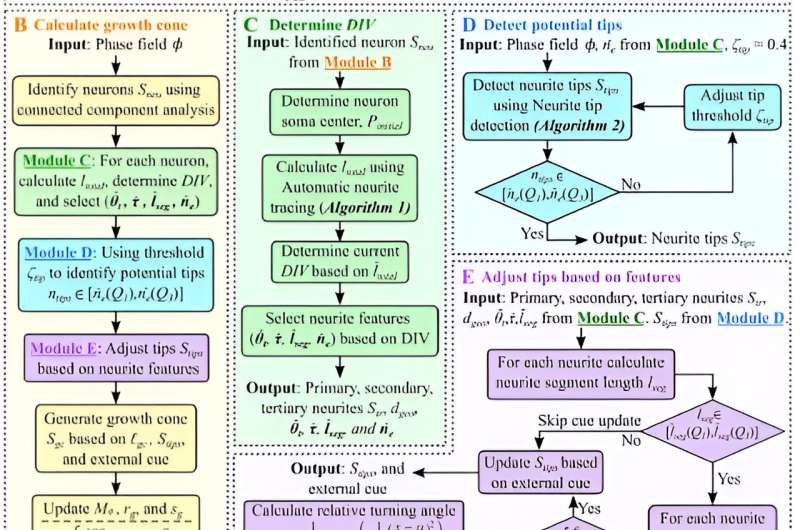This article has been reviewed according to Science X's editorial process and policies. Editors have highlighted the following attributes while ensuring the content's credibility:
fact-checked
trusted source
proofread
Branching out: Modeling neurons in new ways

Nothing is easy to predict, especially not the development of organisms. However, predicting neuron cell growth has just become a little bit easier, thanks to CMU researchers.
Jessica Zhang, a professor of mechanical engineering, and students in the Computational Bio-Modeling Lab created a computational model that could predict, with 97.7% accuracy, the different stages of how rodent neuron cells would grow in vitro. They hope to use this model to figure out why neurons grow the way they do.
Their research is published in Computer Methods in Applied Mechanics and Engineering (CMAME). Vickie Webster-Wood, an assistant professor in mechanical engineering, and Ph.D. mechanical engineering student Ashlee S. Liao contributed to the experimental side of this research. Liao is co-advised by Webster-Wood and Zhang.
"We are hoping to use our computational tools to investigate morphological-related neuron degeneration," Zhang said. "The computational tool that we are working on can provide the capability for us to move further."
Liao measured the total and segment lengths, growth angles, and tortuosity—or the twists and turns—of immature lab-grown neuron cells as they developed over six days. The cells were then imaged, and all of this data was used to create the computational model that predicts the path of neuron growth cones—a structure in neurons that determines how the cell will grow and develop.
"That is the key point in this study," Zhang said. "The growth cone, also called the growth factor, is a very important indicator or metric that influences the mature neurons in the future in developing certain degenerative neuron diseases."
One of the challenges of this study was bridging the gap between experiment and computation, according to Zhang. The researchers needed to find a way to blend different models and modes of research into one.
"From the experimental side or from the computational side, there were many times we couldn't define a good way to compare results from these two fields. It's not that straightforward," Zhang said. "This could maybe provide some inspiration, some clue for how to fuse these two areas together."
There's still a lot of work to be done in studying neuron degeneration, according to Kuanren Qian, a mechanical engineering Ph.D. student who worked on the research. But this work has the potential to contribute to several impactful results.
"The idea is that our model could provide a computational tool for people who are studying those diseases, in a way that was really hard to do previously with just experiments," Qian said. "Another future direction that we could explore is to study how we can guide the growth. There are some potential applications in building a nervous system for biohybrid robots."
More information: Kuanren Qian et al, Biomimetic IGA neuron growth modeling with neurite morphometric features and CNN-based prediction, Computer Methods in Applied Mechanics and Engineering (2023). DOI: 10.1016/j.cma.2023.116213




















